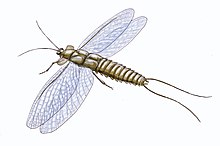Mazothairos
| Mazothairos Temporal range:
| |
|---|---|

| |
| Speculative reconstruction of Mazothairos enormis | |
| Scientific classification | |
| Domain: | Eukaryota |
| Kingdom: | Animalia |
| Phylum: | Arthropoda |
| Class: | Insecta |
| Order: | †Palaeodictyoptera |
| Family: | †Homoiopteridae |
| Genus: | †Mazothairos Kukalová-Peck & Richardson, 1983 |
| Species: | †M. enormis
|
| Binomial name | |
| †Mazothairos enormis Kukalová-Peck & Richardson, 1983
| |
Mazothairos (from Mazo, derived from its location of Mazon Creek and θαιρός, thairos, meaning 'hinge' in Greek)[1] is an extinct genus of very large insect from the Carboniferous period. It was a member of the order Palaeodictyoptera. Although it is only known from very fragmentary remains from a single fossil, it is estimated to have had a wingspan of about 56 centimeters (22 in), making it one of the largest-known insects, only being rivaled in size by the largest members of the order Meganisoptera, such as Meganeura and Meganeuropsis.[1]
It is the largest known member of the order Palaeodictyoptera, a group of insects characterized by their distinctive beak-like mouthparts, which possibly had a sucking pump-like organ that might have been used to pierce plant tissues and drink their liquids.[2] The group is also known for the pair of winglets on the prothorax in front of the first pair of wings of its members, which gave them the epithet of "six-winged insects".[3][4][5][6]
The Holotype fossil of Mazothairos was found in the Mazon Creek fossil beds in modern-day Illinois, a lagerstätte formed approximately 309 million years ago during the Pennsylvanian epoch of the Carboniferous period, which is thought to have been a part of a river delta system and have had a tropical climate.[1]
See also
References
- ^ doi:10.1139/z83-218.
- ISBN 0-19-510033-6.
- S2CID 92618669.
- PMID 29374449.
- PMID 27853616.
- S2CID 4336906.
